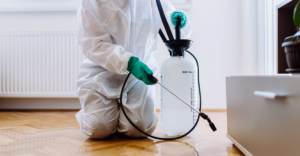Pests are organisms that damage or spoil crops, living areas or human possessions. Control methods include prevention, exclusion, traps and chemical sprays.
Preventing pest problems is often easier than controlling established infestations. For example, keep outdoor rubbish bins tightly sealed and remove places where pests can breed. Contact Pest Control Boston now!

Drain puddles regularly to prevent mosquitoes from breeding, and keep birdbaths clean. In addition, nematodes (microscopic, eel-like worms) can be u“sed to kill insects in the soil.
Pest Identification
As part of a pest control program, properly identifying pests is an important first step. This helps to determine whether action is necessary and can also help select the best control tactics. Proper pest identification requires familiarity with a pest’s life cycle, habitat requirements, time and location of occurrence, and reproductive habits. The pest’s damage to plants, structures or property and its feeding indicators can also provide clues to its identity.
A key tool for scouting is a good flashlight, which allows inspection of dark, secluded, and inaccessible places where pests often hide. An extendable mirror can be especially helpful, enabling inspectors to see beneath equipment and other items that may be harboring pests. Also useful is a magnifying glass to help identify insect parts, frass (excrement), and other signs of infestation.
Pests are any organism that reduces the availability, quality or value of a human resource and is not an essential part of the natural environment. This includes diseases, plant pathogens, weeds and other non-native species, and animals that invade human living or working spaces.
Those organisms that directly reduce the production or consumption of crops or ornamentals are considered agricultural pests. Diseases are also considered pests, as they are typically considered undesirable and detrimental to the health and well-being of the crop or landscape. Insects that feed on crops and/or damage structures are also considered pests, as are weeds and vertebrates that interfere with cultivation and landscaping objectives.
Once a pest has been identified, prevention and suppression become goals. Preventing a pest from becoming established is usually the most effective and economical approach. Suppression is aimed at reducing the population to a level where it no longer causes unacceptable harm.
Achieving these goals is not always easy, however, especially for invasive species and those that are resistant to conventional control methods. Proper identification is the first step in successful pest management and can lead to the development of more targeted and safer pesticide application techniques. This can ultimately translate into more environmentally friendly and sustainable agribusiness practices. This is an ongoing process, as pest populations are often cyclical and may be difficult to eliminate entirely.
Pesticides
Pesticides are chemicals that kill or control pests (plants, animals, disease carriers). They are a necessary part of many farming practices, as well as in the home garden and for indoor pest control. There are many types of pesticides, including insecticides, herbicides, fungicides, rodenticides and wood preservatives. Some pesticides are fast acting and break down quickly, while others linger in the environment for days or even weeks.
The Environmental Protection Agency (EPA) regulates pesticides in the United States. It does this by establishing standards, conducting research, sponsoring partnerships, educating the public and publishing information. Each state government also has a system for reviewing and approving pesticides.
EPA-registered pesticides are intended to prevent or reduce damage caused by certain insects, plants, microorganisms or diseases. They may be synthetic or natural products. The EPA reviews the safety of all registered pesticides. It registers those that are considered safe enough for use in and around homes, schools, hospitals, restaurants and other public buildings. It also reviews the health hazards associated with a product and its possible impacts on the environment.
Some of the most common pesticides include herbicides, insect growth regulators, fungicides and rodenticides. Herbicides kill unwanted plants, while fungicides control fungal problems such as mildew and rust. Rodenticides kill rats, mice and other rodents. Wood preservatives make wood resistant to fungus and insects.
Pesticides are available in liquid, solid and gaseous forms. The form affects how quickly it enters your body and how it will affect you. Liquid pesticides are available as suspensions, solutions and emulsifiable concentrates. Solid pesticides are available as dusts, granules, pellets and soluble granules. Gaseous pesticides are usually fumigants.
The type of pesticide you select will depend on the problem you are trying to solve. Always read and follow label instructions carefully, especially the safety instructions. If you are not sure how to use a pesticide safely, consult an expert.
The best way to avoid using pesticides is to keep pests out of your yard and garden. Try non-chemical methods first. If you do use pesticides, only apply what is needed and use it sparingly. Always keep children and pets out of areas where pesticides are used, and store them properly when not in use.
Baits and Traps
As the name suggests, traps and bait stations are devices used in pest control to lure rodents and kill them with poison. Typically, the bait is in the form of pellets or blocks that contain a chemical that is lethal to rodents. The traps and bait stations are placed in areas where rodents live such as under buildings or near their nests and food sources. The stations are often designed to be childproof and difficult to open by curious pets or wildlife such as birds. These types of baits are highly effective over a long term when properly placed and maintained.
When a rodent consumes the poison, it will die within a few days. Often, the rodent will die in or near its den or nest. The dead rodent may leave a foul odor that may attract other pests to the area. The odor can also deter predators from consuming the dead rodent.
Many different types of traps and baits are available to control rodents. Choosing the best bait and trap for a particular situation requires an understanding of the pest, the environment in which it lives, its behavior, and how and where it travels. Traps that are set too soon or that do not acclimate the pest to their presence will be less effective. For example, rats usually scurry along the edges of rooms and near walls where they feel safest. Placing traps in the middle of a room will likely not catch any rats.
Trappers who concoct their own lures and baits are often highly protective of their formulations. It is not uncommon for them to work on their formulas for years before they produce a product that is both effective and easy to use. This type of trapping is especially important when working on a large scale, as it can save time, effort and resources.
Eradication of some pests is often impossible, especially when they have become adapted to new environments. This is why many pest management programs are aimed at prevention and suppression. However, in some cases such as with the Mediterranean fruit fly, gypsy moth and fire ants, eradication is a realistic goal.
Exclusion
Pest exclusion is an important part of Integrated Pest Management. It involves repairing and sealing entry points in buildings to keep pests out. It’s a proactive approach that can reduce the need for chemical treatment and prevent damage to building materials, furniture and equipment.
A pest exclusion specialist uses caulking, sealant, spray foam and other products to close gaps around the facility’s foundation, roof, doors, windows, vents, electrical boxes and utility pipes. They also look for openings in window wells and any cracks or holes in the foundation or walls. For areas that can’t be closed, such as drainpipes and vents, they can use copper mesh that still allows water to flow out or air to get in but deters rodents, birds, and bats.
Properly performed pest exclusion is one of the most cost-effective ways to reduce pest problems. The work can be challenging and time consuming, so it’s best done by professionals with the appropriate tools and knowledge. It’s also a good idea to do a thorough inspection and perform maintenance at least twice per year. This will ensure that the products are working and that pests haven’t found other ways to enter the building.
Another way to prevent pests from gaining access to the facility is to remove weeds, debris and garbage from the property. It is also important to trim and remove branches, bushes, vines and other plants that touch or hang over the building, as they provide shelter and food for wildlife and rodents.
While it’s true that pest control companies have to continually offer insecticides and other reactive treatments to address infestations, the future of the industry lies in preventative exclusion. In the long run, this is a more effective and less costly approach than continuing to fight fire with fire.

